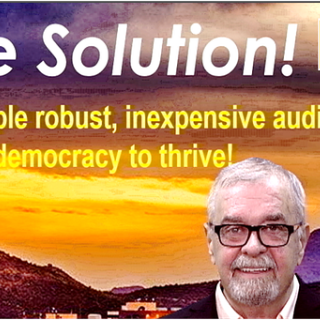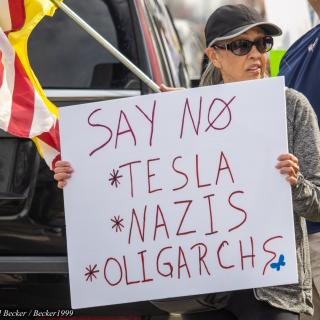Advertisement
After the recent news that federal grants reached a new milestone for supporting solar in communities across the country, with $1 billion in grants allocated through the rural energy program alone, Solar United Neighbors is celebrating the success stories in Ohio where grants made a difference.
Most recently, Paula Mackovjak of Brunswick went solar in 2024 with the help of federal incentives available through her employer. By going solar she is saving on her monthly electric bills and hedging against the rising cost of power.
Paula’s success story mirrors the broader national movement, where communities from Georgia, Michigan, Wisconsin, and Minnesota to Virginia, West Virginia, Florida, and beyond are reaping the rewards of going solar with federal support.
Read more about her and other solar successes in Ohio below.
When noted, participants are available for interviews, as are solar experts with the nonprofit Solar United Neighbors (SUN).
Paula Mackovjak, solar homeowner in Brunswick, OH.

Paula Mackovjak’s journey to becoming a solar homeowner began at the source — when she took a job with a solar installer. Her interest in solar was prompted by summertime energy bills that topped $500. A desire to better understand the technology and find a new line of work led her to the industry.
Soon after beginning her new career, Paula started planning an installation of her own. In February 2024, Paula and her husband installed a 13 - kilowatt roof - mounted array on their home in Brunswick, Ohio. The couple benefited from the federal solar Investment Tax Credit (ITC), which will earn them a 30 percent credit on their 2024 taxes. This represents $17,000 in savings off the cost of their system.
These savings were made possible by the Inflation Reduction Act (IRA), which increased and extended the ITC. “The 30 percent [tax credit] is a beautiful thing,” said Paula Mackovjak. The system is producing enough power to cover nearly all of Paula’s energy demand.
Paula is proud to have established her energy independence. “My mindset is 100 percent we should be able to own our own power.” Having experienced the benefits of distributed renewable energy herself, Paula now hopes to help others go solar too.
St. Mark’s Lutheran Church: Faith in Solar in Delaware, Ohio
St. Mark’s Lutheran Church has served the Delaware, Ohio, community for over 200 years. Since December 2023, they have powered their mission with solar energy, thanks to the IRA’s direct-pay provision, which enables tax-exempt organizations like churches to receive a direct payment instead of a tax credit. The church installed a 49-kilowatt solar system that now powers 100% of its energy needs, reducing their annual electric bill to zero.
“We got going on this because of that 30% rebate,” said Louis Iverson, a retired ecologist and chair of the church’s Stewardship Council. “That was critical.” St. Mark’s will receive a $35,000 rebate through the IRA, and the savings will allow them to reinvest in community programs like food donations and youth summer camps.
This success aligns with the church’s mission of creation-care. “We’re saving huge amounts of carbon emissions, and we’re doing what we can for the changing climate,” shared Iverson. “Being God’s stewards to His creation and taking care of what we have here is vital.” Iverson hopes their story will inspire other congregations and nonprofits to follow suit, demonstrating that solar power is not only feasible but beneficial for communities of faith.
Mike Fanelli, Solar Homeowner in Dayton, Ohio
Mike Fanelli is a solar homeowner from Dayton, Ohio. He went solar through SUN’s Miami Valley solar co-op. His system does more than just power his house, it powers his cars too. And for Mike, solar offered a way to align his energy use with his environmental values. “We own two electric cars. One of them is a plug - in hybrid and the other one is completely electric. I wanted to try to have enough panels to charge those vehicles so that we would basically be running on sun power.
The opportunity to save on the cost of installation through the co-op’s bulk purchase discount, and a 30% federal tax credit helped make his electrification goals a reality. “It definitely was icing on the cake. So, basically, my $12,000 panels are actually only going to cost me about $9,000. So that's pretty reasonable, and it's going to help pay off the panels in a shorter period of time.”
Dayton Friends: Solar-powered Quaker meeting in Dayton, Ohio
Dayton Friends is a Quaker meeting in Dayton, Ohio. As part of the Religious Society of Friends, the group counts stewardship as an important part of their mission. To put their values into action, the meeting participated in Solar United Neighbors’ Miami Valley Co-op and went solar in June 2024. “We wanted to put panels up on our meeting house for both the purpose of reducing our overall electric bill, but also to align ourselves with our values of living sustainably. And we liked the idea of having the panels being visible from the street so as people drive by, they can see what we've done,” said meeting member Dan McGregor.
Direct pay, part of the Inflation Reduction Act (IRA), allows tax - exempt entities like Dayton Friends to be paid for the value of the renewable energy tax credit — 30 percent. This made solar a reality. “It's something the meeting has been thinking about for a number of years, right? But it wasn't until the nonprofit eligibility for the credit became available that we really started to look at it seriously,” shared Dan. The ability to recoup 30% of the system cost led them to install a 2.4 - kilowatt array projected to cover all of their electricity needs.
Glass Rooster Cannery: Solar-Powered Agribusiness in Sunbury, Ohio
Jeannie and Bill Seabrook, owners of Glass Rooster Cannery in Sunbury, Ohio, installed a solar array in 2023, thanks to a REAP grant and the IRA’s 30% federal tax credit. The solar installation powers their no-waste cannery and event venue, helping local farmers turn surplus produce into shelf-stable goods. With their energy costs eliminated, the Seabrooks have been able to reinvest in their staff and continue their sustainability efforts.
“Solar fits perfectly into our vision for sustainable farming and reducing waste,” said Jeannie. “It’s empowering to know we’re using renewable energy to power our business and serve the community.”
A Nationwide Movement of Solar Success Stories
Solar power is rapidly expanding across the U.S., with a record 32.4 GW of new capacity added in 2023, including 22.5 GW of utility-scale installations. This represents a 51% increase from the previous year and a 37% jump over the prior record set in 2021. The country’s total solar capacity now stands at 177 GW, and with continued support from federal policies like the Inflation Reduction Act (IRA), deployment is projected to quadruple in the next decade. The IRA has also fueled an 89% growth in U.S. solar module manufacturing in 2023, making solar more affordable, reliable, and accessible than ever before.
Ohio’s solar success is part of this broader national trend. With federal support through the IRA, communities across the U.S. are adopting solar energy to reduce energy costs, enhance sustainability, and empower local economies. For example:
In Michigan, Brian Hayden from Ann Arbor installed solar on his home through a local Solarize campaign, offsetting his household’s energy use with a 7.5-kilowatt system. Meanwhile, Adam Schaller of Lakeshore Die Cast in Baroda integrated solar into his manufacturing operations, allowing his business to offset 100% of its energy costs and sell excess power back to the grid.
In Georgia, veteran and former EPA employee Jay Bassett went solar through the Solarize Gwinnett program. His system powers two-thirds of his household energy needs, while he organized his community to donate Renewable Energy Credits (RECs) to local nonprofits, furthering sustainability efforts in the area.
In Wisconsin, Tony Schultz of Stoney Acres Farm has used solar to cover 75% of his electricity needs, while Paul Huber of Troy Farm achieved net-zero energy costs. Both are examples of how solar energy can sustain small, family-owned farms in rural areas.
In Minnesota, dairy farmer Art Thicke of Enchanted Meadows and berry farmer Stuart Lavalier of Grand Rapids have achieved complete energy independence through solar. Both farms now generate more power than they need, selling the excess back to the grid.
In Virginia, Janet Aardema of Broadfork Farm transitioned her agricultural operations to solar, reducing her energy bills significantly and reinvesting in sustainable farming practices.
In West Virginia, East West Printing and Still Hollow Spirits have integrated solar into their operations, cutting costs and aligning their businesses with environmentally conscious practices.
In Florida, businesses like John Kocol’s Island Hammock Pet Hospital and Nick Wishnatzki’s Wish Farms have adopted solar, enhancing their operations while reducing environmental impacts.
And more!
Supporting Ohio’s Solar Transition
Ohio residents and businesses interested in learning more about going solar and how incentives can benefit them can download SUN’s Go Solar guide:https://act.solarunitedneighbors.org/a/go-solar-guide
Or contact SUN’s Solar Help Desk, which takes the complexity out of solar so individuals can make informed decisions: https://solarunitedneighbors.org/help-desk/.
About Solar United Neighbors
Solar United Neighbors is a nonprofit organization that works in Ohio and nationwide to represent the needs and interests of solar owners and supporters. Solar United Neighbors holds events and education programs to help people become informed solar consumers, maximize the value of their solar investment, and advocate for fair solar policies.
CONTACT
Seth Newmeyer
Communications
Solar United Neighbors
202-227-5434
snewmeyer@solarunitedneighbors.org
Ways to Support Solar: Go Solar Volunteer Donate
Are you or is someone you know a federal employee? The CFC Campaign is underway and now is a great time to support SUN through an easy payroll deduction. Find Solar United Neighbors in the CFC online portal by looking for #86613. Click here for more information on the CFC campaign.



